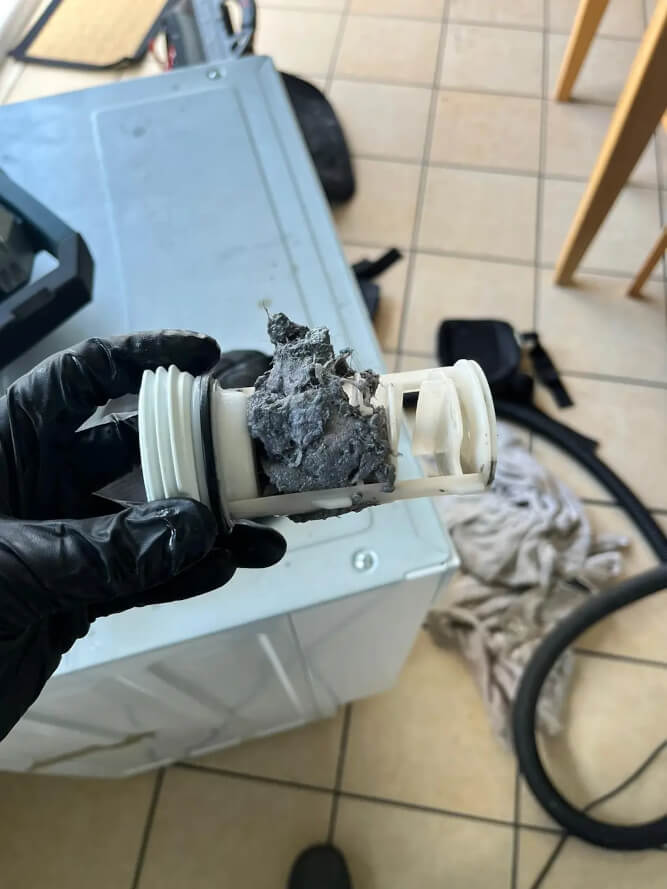During the summer months, our washing machines work overtime with kids at home, outdoor activities in full swing, and sweaty weather contributing to an ever-growing washing pile. It’s no surprise that this increased usage can lead to common issues like clogs and leaks. To help you keep your washing machine running smoothly, we’ve compiled our top tips for preventing clogs this summer. And if you’re already facing a clog, don’t worry – we’ve got you covered with solutions to unclog your machine too!
Shake Out Excess Dirt And Debris
Before tossing clothes into the washing machine, shake out any excess dirt, sand, or debris. This is especially important for swimsuits, beach towels, and play clothes.
Use A Mesh Laundry Bag
Place small items like socks, underwear, and delicate fabrics in a mesh laundry bag. This helps prevent them from getting stuck in the washing machine’s drain.
Check Pockets
Always check and empty pockets before washing clothes. Items like coins and small toys can cause clogs in the washing machine. If you have ever left a tissue in your pocket – you will know what a mess it can make!
Clean The Lint Filter
Regularly clean the washing machine’s lint filter, which is often located near the agitator or along the drum’s rim. This helps prevent lint buildup that can lead to clogs.
Use The Right Detergent
Using too much detergent or the wrong type can create excess suds, which can contribute to clogs. Check your user manual for details on the best detergent type for your make and model.
Run Regular Maintenance Cycles
Run an empty hot water cycle with a cup of vinegar or a washing machine cleaner once a month to help dissolve soap scum, mineral deposits, and other residues.
Avoid Overloading The Machine
Heavy loads can overtax the washing machine, causing it to overflow and leak a large amount of water at once. Washing more clothes and linens increases the possibility of the clothes not rinsing properly, leading to washing machine drain clogs caused by soap residue building up in the line and a greater amount of lint and fabric particles that need to be drained. Follow the manufacturer’s load capacity recommendations.
Clean The Pump Filter
Check and clean the pump filter regularly, which can collect lint, small items, and other debris. Refer to your machine’s manual for instructions on how to access and clean this filter.
Inspect Hoses And Drains
Periodically inspect the washing machine hoses and drains for any signs of wear, leaks, or blockages. With increased washing machine use, a leak in the water supply hoses could pop up during the summer. These hoses typically last 3 to 5 years, but many homeowners do not realise they should be periodically replaced. Replace hoses every five years or as needed.
Dry Clothes Properly Before Washing
If clothes are excessively muddy or wet, consider drying or rinsing them off outside before washing. If you have budding footballers and rugby players in your household, it is especially worthwhile to do this exercise when it is your turn to wash the team kit to reduce the amount of dirt and debris entering the machine!
How Will I Know If My Washing Machine Is Clogged?
The drain filter pump is the component that catches all the lint, hair, and other small objects such as shirt buttons, pocket crumbs and small coins that are often undetected before clothing is put into the machine for a wash.
The biggest telltale sign that your washing machine’s drain pump filter is bunged up is when your clothes are wetter than normal after a cycle finishes, or the cycle takes longer than usual.
How Do I Unclog My Washing Machine?
To get rid of all the gunk and build up in your washing machine pump filter (and prevent clogging) follow the following 7 effortless steps:
- Turn off and unplug your washing machine.
- Have a small container at the ready to catch any water that shoots out.
- Open the cover and unclip the drain hose.
- Remove the cap and drain the hose into the container.
- Once it is completely drained, you can remove the filter (clean in the space where the filter was too).
- Wipe the filter clean (or wash clean with a toothbrush under running water to remove the film).
- When you are happy that everything is as clean as it can be, put all the components back together again.
Be aware that each washing machine is different so before you tackle this chore, check your owner’s manual for cleaning details.
Don’t despair, if you are not comfortable with unclogging your washing machine yourself, or you are not sure what is causing the blockage or leak, our expert plumbers would love to help. If you are located within our service area, give us a call at your convenience, and we’ll sort the rest.

